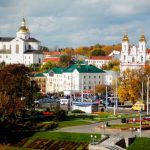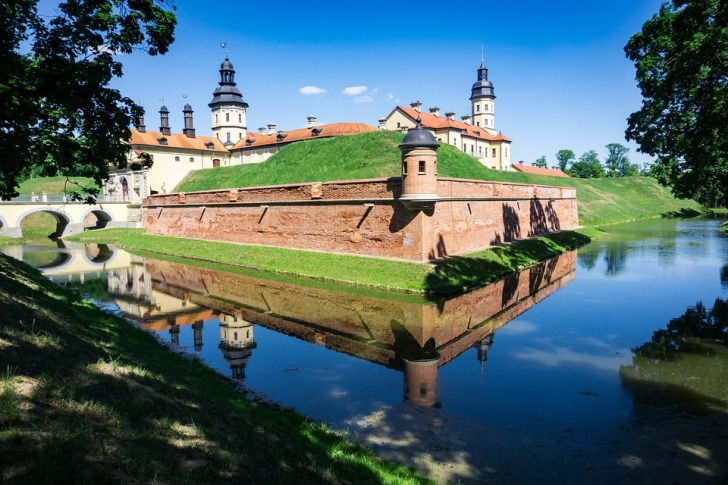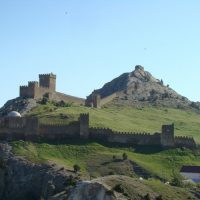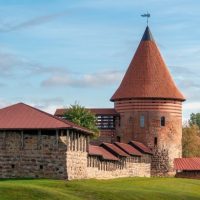Belarus is a landlocked country in eastern Europe.
It is bordered by Russia to the east, Poland to the west, Lithuania and Latvia to the north, and Ukraine to the east.
There are approximately 29 castles, ruins, and fortresses in Belarus.
Belarus is a country rich in history, archeology, and beautiful structures.
The country has recently opened its borders and has quickly become a top destination for tourists from around the world.
In this list, we take a quick look at ten of the most beautiful castles that Belarus has to offer.
10 Most Beautiful Castles in Belarus
1. Nesvizh Castle
We start our list with the fairytale castle known as Nesvizh Castle, located in Niasviž, Belarus.
This is a residential castle owned by the Radziwiłł family.
The architecture is a mixture of Baroque architecture and Renaissance architecture.
The castle was built between the 16th and 17th centuries and sits approximately 600 feet above sea level.
In 1995, the castle, a nearby church, and the surrounding area were included in the UNESCO World Heritage List.
The castle and surrounding area have largely been preserved in their original state.
The Radzwill family exercised great influence in Central and Eastern Europe in the fields of art, architecture, science, and crafts.
The structure consists of the Corpus Christi mausoleum church, the residential castle, and a garden that surrounds the building.
There are ten interconnected buildings within the entire structure of the castle, which include galleries, the family residence, the arsenal, the family archive, and the palace itself.
2. Gomel Palace
The palace, also the Rumyantsev-Paskevich Residence, is an important piece of architectural history, and a focal point of the city of Gomel in Belarus.
The grounds of Gomel Palace stretch along approximately 2,630 feet of the right side of the Sozh River.
A very interesting point and measure of its importance to the Belarusian people is the fact that an image of the residence features on the Belarusian 20-rubel note.
The palace was constructed in the 18th century and hosts a theater, a library, and a museum.
It is one of the most popular tourist destinations in Belarus and attracts visitors from all over the globe.
During the 18th century, the grounds belonged to the Russian Empire.
The palace was gifted to General Field Marshal Piotr Rumyantsev-Zadunaisky by Empress Catherine the Great.
She gifted the palace to him for his outstanding work in the war against Turkey.
Visitors can take a walk through the botanical enclave found on the palace grounds or explore the museum to view over 95,000 artifacts and historical memorabilia.
In addition, visitors can learn about the history of the parks and monuments on the castle grounds.
3. Liubča Castle
This castle, another residence of the Radziwill family, is located on the left bank of the Neman River in a town called Liubča.
The castle was established in 1581 as the residence of the Calvinist magnet, Jan Kiszka.
Back then the castle had one stone tower and wooden walls.
Three moats surrounded the river and one side of the castle was protected by the river.
The castle was later given to Janusz Radziwiłł, who continued to expand on it and added three more stone towers.
Over the preceding centuries, the castle would repeatedly change hands and suffer serious damage due to wars and invasions.
In 1947, the remains of the structure were remodeled into a school building and then later a museum.
Today, only two of the towers remain.
But the castle still attracts visitors who come to fish or enjoy the sunset on the river bank.
4. Kossovo Castle
Kossovo Castle, located in Kosava, Belarus, is a ruined castellated palace designed in Neo-Gothic architecture.
The palace offers panoramic views of the surrounding gardens.
In 1821, the estate was purchased by Count Wojciech Puslowski, who left the estate to his son, Wandalin.
It is considered to be a cultural landmark in Belarus.
The castle consists of two wings that are attached to a central two-story structure.
There are 12 towers, each representing a month of the year.
The four towers in the middle, the largest of all the towers, represent the harvest months of May, June, July, and August.
The castle is most famous for its beautiful halls, each one hosting a different affair.
The white halls hosted the balls, the black halls hosted card games, and the pink halls hosted music.
The castle is massive, consisting of over 100 rooms and chambers.
The palace is located in a vast garden and boasts over 150 different exotic species of plants.
5. Mir Castle
Mir Castle, located in the Kareličy District of Hrodna Voblaść, in the town of Mir, is a UNESCO World Heritage Site and a historic fortified castle in Belarus.
The architectural design of the castle is a combination of Gothic architecture, Baroque architecture, Renaissance architecture, and Belarusian Gothic architecture.
The castle was founded in 1520.
Today, the castle consists of the Prince Svyatopolk-Mirsky, a roadside chapel, an outbuilding, ruins from the previous owners, a museum, the watchmen’s house, an English landscape park, a pond, as well as the remains of an Italian garden.
There are 39 exhibition and exposition halls in the museum.
The castle hosts sightseeing tours, theatrical tours, and thematic tours.
The castle is known for hosting several weddings throughout the year and boasts a hotel with 16 rooms, two conference halls, as well as an old-fashioned restaurant.
The craft shop sells souvenirs from Belarusian craftsmen that tourists can take home to treasure their visit to the castle.
6. Lida Castle
This castle was built by Grand Duke Gediminas of Lithuania in the 14th century to protect his lands against the expansion of the Teutonic Knights.
The castle is considered to be an archaeological monument.
It is the crimson walls, the trapezium shape, and the ornate brickwork that make this castle so well-known.
After being damaged many years ago, the castle has been restored and one of its towers now hosts a natural history museum.
The castle attracts visitors from all corners of the world and is an all-season tourist attraction.
During the summer, the castle hosts knight’s tournaments, while its inner yard is transformed in the winter into an ice skating ring.
7. Brest Fortress
This fortress, formerly known as Brest-Litoŭsk Fortress, is located in a city by the same name.
The fortress was constructed in the 19th century.
The fortress sits on the Belarusian border with Poland.
There are two levels to the fortress and an impressive 6,561 feet of barracks.
The fortress features amazing artwork, churches, monasteries, cathedrals, and other structures within the walls of the fortress.
The fortress is also known as the ‘Hero Fortress’, due to its service and defense of the country during WWII.
Today it is distinguished as a major war memorial that can be identified by the brutalist concrete statues that overlook the fortress.
Sadly, the fortress was badly damaged during the war and many of the damaged parts were never restored.
8. Old Grodno Castle
The castle, located in Grodno, Belarus, is the seat of a dynasty of Black Ruthenian rulers and originated in the 11th century.
The first and original castle that was constructed was made of wood and situated between the Neman and the Gorodnichanka rivers.
The palace was originally the residence of the Grand Dukes of Lithuania and the kings of Poland.
From the 12th century to the Middle Ages, the castle survived a fire and several attacks and was restored several times by architects throughout the centuries.
The castle has changed hands several times.
In 2015, reconstruction started on the castle to restore it to its former glory.
Today, it hosts the Grodno Museum of History and Archaeology.
9. Babruysk Fortress
Babruysk Fortress, located in the city of the same name, is a historical fortress built in the period between 1810 and 1836.
It is a western Russian fortress and an outstanding example of fortification architecture.
It is often considered to be the best-equipped fortress in the Russian Empire.
The fortress has a long history and has undergone several restorations through the centuries.
Today, it is used in archeological studies, excursions, and filming.
10. Mozyr Castle
This castle is located in the Gomel Region of Belarus and was constructed in the 15th century.
It is a major tourist attraction and is often visited to get a feel for the culture of Belarus.
Today it is a museum that showcases the history of the area and the country through the many artifacts that can be found in the museum.
In addition, the castle hosts many festivals, wedding ceremonies that mimic the Middle Ages, and various theatrical performances.
Belarus Safety Overview
READ THE FULL REPORT: Belarus Safety Review
Safety Index:
- OVERALL RISK: LOW
- TRANSPORT & TAXIS RISK: LOW
- PICKPOCKETS RISK: MEDIUM
- NATURAL DISASTERS RISK: MEDIUM
- MUGGING RISK: LOW
- TERRORISM RISK: LOW
- SCAMS RISK: LOW
- WOMEN TRAVELERS RISK: LOW
Frequently Asked Questions
Who is Belarus ruled by?
Alexander Lukashenko.
Alexander is the official president of Belarus and has been in office since 1994, making him the only president that the country has ever known.
Previously, Belarus was under Russian control when it was taken over by Stalin in 1944 and remained under soviet rule until it reached independence in 1990.
Does Belarus still belong to Russia?
No, on August 25, 1991, the country gained its independence.
What's Belarus famous for?
Belarus is considered to be one of the poorest countries in Europe by total wealth, even though the country has one of the lowest unemployment rates in Europe.
But the country is known for more than just its financial position.
It is also known for its potatoes and tractors, and for being one of the last countries in Europe to still be ruled by a dictator.











